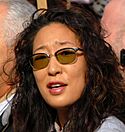Korean Canadian facts for kids
| Total population | |
|---|---|
| 223,322 (2009 South Korean gov't figures) 141,875 (2006 Canadian Census) |
|
| Regions with significant populations | |
| 69,540 | |
| 50,490 | |
| 12,045 | |
| 5,310 | |
| 2,190 | |
| 795 | |
| 740 | |
| 625 | |
| 70 | |
| 60 | |
| 10 | |
| Languages | |
| Korean, Canadian English and/or Canadian French | |
| Religion | |
| Protestantism (50%), Catholicism (25%), No affiliation (20%), Buddhism (4%) | |
| Related ethnic groups | |
| Koreans | |
|
These numbers are based on how many Koreans register with the South Korean government when they live outside Korea. This helps them with things like taxes and schooling. |
|
Korean Canadians are people living in Canada who have Korean family roots. They are one of the largest groups of Koreans living outside of Korea. In 2009, over 223,000 people of Korean background lived in Canada. This makes Canada home to the fourth-largest Korean population outside of Korea.
Contents
History of Korean Immigration to Canada
The first Koreans to come to Canada were Christians. They came to study Christianity with Canadian missionaries. By 1965, only about 70 Koreans lived in Canada.
After 1966, Canada changed its immigration laws. This made it easier for people from South Korea to move to Canada. Between 1970 and 1980, over 18,000 Koreans immigrated. Another 17,500 came in the 1990s.
In the late 1990s, South Korea became the fifth-largest source of immigrants to Canada. Many Koreans chose Canada because of economic reasons. At that time, it was harder to find jobs in Korea. Also, the Canadian dollar was weaker, meaning Korean money went further in Canada.
Many Koreans also knew about Canada because Canadian teachers worked in Korea. This made Canada a familiar and welcoming place. Some Koreans even moved to Canada from the Korean population in China.
Where Korean Canadians Live
Today, Toronto has the largest number of Koreans in Canada. However, Vancouver has seen the fastest growth in its Korean population. Since 1996, the number of Koreans in Vancouver has grown by 69%. Montreal has the third-largest group of Korean immigrants.
In 2001, more Koreans moved to Canada than to the United States. Many temporary residents, like students, also came to Canada. South Korea sent the most international students to Canada in the late 1990s.
Korean Canadians Today
Many Korean Canadians are well educated. New immigrants and their children often work as skilled professionals. These include doctors, professors, engineers, and computer technicians. Many also become business owners.
Korean Canadians can be grouped into three types:
- First generation: These are people who were born in Korea and moved to Canada as adults.
- 1.5 generation: These people started school in Korea but moved to Canada when they were children or teenagers.
- Second generation: These are people who were born in Canada to Korean parents.
Each group is unique, but Korean Canadians are very proud of their Korean culture. They keep their culture alive through many activities. These include local cultural events, university groups, and seniors’ groups. They also have language schools and business networks.
Culture and Community
In cities like Vancouver and Toronto, you can find Korean-language newspapers. There are also Korean television and radio programs. Korean dance, music, and art are popular in Canada. Martial arts and Korean cuisine are also very well-liked.
Many Korean Canadians are Christians and often attend Korean churches. A smaller number are Buddhist or do not follow a religion.
Demographics of Korean Canadians
In 2007, the South Korean Ministry of Foreign Affairs and Trade collected information about Koreans in Canada. They found that over 86,000 were Canadian citizens. About 72,000 were permanent residents. There were also many people with student visas or other temporary permits.
The Canada 2001 Census reported about 101,000 Canadians of Korean background. However, Korean community leaders believe the actual number is higher. This is partly because many temporary students might not be counted in the census.
In 1996, the Canadian census showed that 53.6% of Korean immigrants had a university degree. This was much higher than the 23% of other Canadians with degrees. However, Canadian employers often prefer degrees from Canadian schools. Because of this, some Korean immigrants work in jobs that are different from what they studied in Korea. About 40% worked in family-owned businesses. Their average income was also lower than other Canadians.
Images for kids






